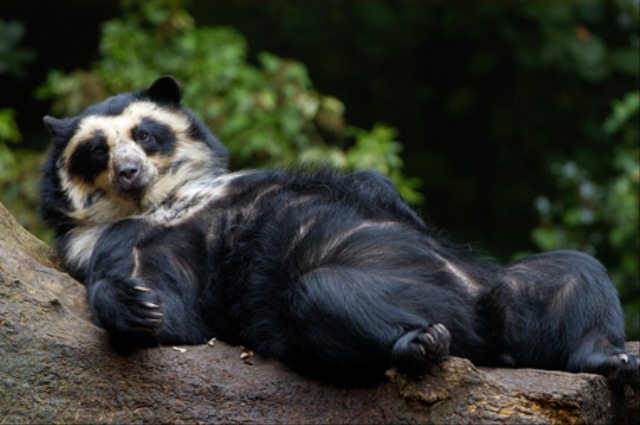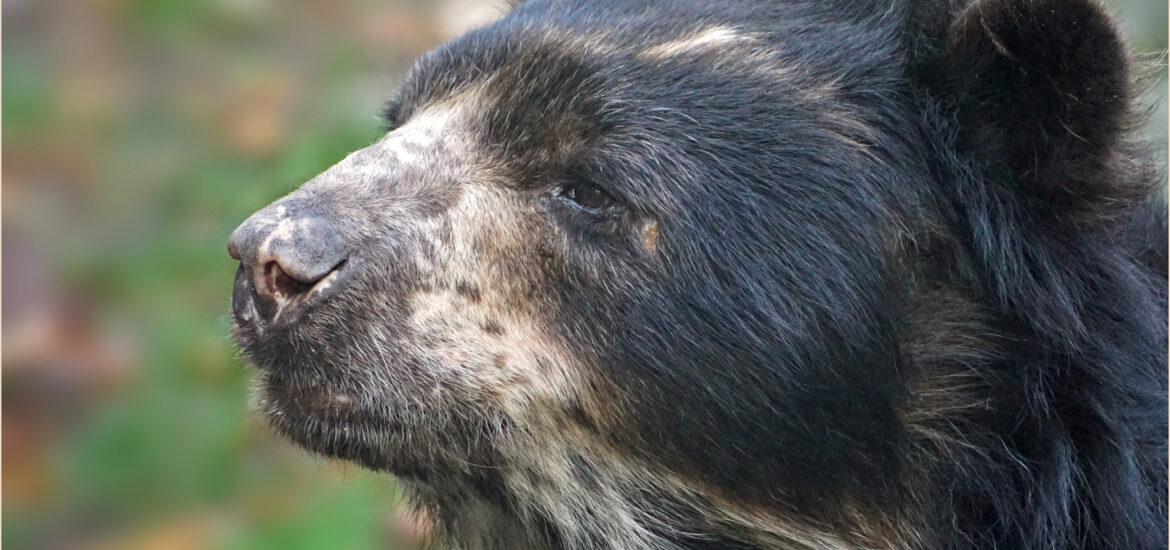The Peruvian Andes hold one-in-a-kind fauna and flora. One of its best-kept secrets is the Andean bear or spectacled bear (Tremarctos ornatus). In the Quechua language, people know it as “ukumari.” This cute bear is the only endemic of the tropical Andes, and for Peru, it’s more than just a bear.
The spectacled bear represents Peruvian fauna and the vast life diversity you can find in our country. Let’s discover more details about this bear, and how we can contribute to fighting the dangers that face its existence.
Appearance and diet
What makes this bear different is the creamy white or yellowish rings around their eyes. They look like oversized glasses. However, not every bear sports a complete “pair,” as these markings can vary greatly or be absent altogether.
Their shaggy coats range from deep black to reddish-brown. They have unique markings on their throats and chests. Think of it as each bear having its own fashion-forward fingerprint! Compared to their bear cousins, spectacled bears are on the smaller side.

Males can reach between 1.30 and 1.90 cm in length and weigh up to 130 kg, while females are more petite, maxing out at around 90 kg. Despite their weight and size, they’re agile climbers. You can see them often lounging on tree-top platforms made of broken branches.
Spectacled bears are primarily vegetarians, feasting on fruits, berries, cacti, and tree bark, but they can also eat small animals, insects, and even livestock, which earns them a bad reputation with farmers. They’re particularly fond of bromeliads and orchid bulbs, which their strong jaws and flat molars make easy work of.
Habitat and Distribution
These bears are gentle creatures that enjoy the peace of cloud forests on the Andean slopes, often reaching heights of 4000 m.a.s.l. This bear can be found from the Venezuelan Andes to the Bolivian moorlands. In Peru, it thrives in regions such as Amazonas, San Martin, or Cusco.
One of the most iconic places to see these bears is the Machu Picchu citadel, where many visitors have spotted even spectacled families. These creatures showcase an incredible capacity to adapt to low and high altitudes.
Of course, this is no easy task, but they can live in They also thrive in many places. These include cloud forests, dry thorny forests, and the Andean highlands. Their ability to adapt to different habitats is truly remarkable! However, their love for remote areas makes it a bit challenging for researchers to learn more about them.
Reproduction: A Tale of Solitary Romance
Spectacled bears are solitary creatures, meaning they spend most of their lives alone. However, in the mating season, which is usually in April and June, males and females briefly court each other. Females have a fascinating reproductive strategy called delayed implantation.

After mating, the fertilized egg doesn’t immediately attach to the uterine wall. This delay allows the mother to time the birth of her cubs with food availability, ensuring the best chance of survival. Gestation lasts around 6 to 8 months, and females usually give birth to one or two cubs in a cozy den made of vegetation.
These tiny cubs, born blind and helpless, rely entirely on their mother. By the time they are about six months old, they start exploring the world but stay with their mom for up to two years to learn essential survival skills.
Why are spectacled bears endangered?
Despite their adaptability, spectacled bears face numerous threats. Habitat loss is the biggest challenge they face, as agriculture, logging, and mining continue to encroach on their homes. With shrinking forests, spectacled bears are forced into smaller, fragmented areas.
It’s now harder for them to find food, mates, and shelter. Another problem spectacled bears face is poaching. Some people think their body parts can be beneficial for health, while some people think they’re livestock predators.
These combined pressures have caused spectacled bear populations to decline sharply. Today, they are classified as “Vulnerable” by the International Union for Conservation of Nature (IUCN). Estimates suggest that fewer than 20,000 individuals remain in the wild.
How can we help protect spectacled bears?
There’s good news: we can take steps to ensure the survival of spectacled bears. Here are a few ways:
Protect Their Habitat: Conservation groups are working to save the forests that spectacled bears call home. They aim to create and expand protected areas, such as national parks. Supporting these efforts can make a big difference.
Reduce Deforestation: Sustainable farming practices and responsible logging can help cut habitat destruction. You can contribute by supporting eco-friendly brands and products.

Raise Awareness: The more people know about spectacled bears, the better. Share their story with friends and family, and on social media, to spread the word.
Support Conservation Groups: The Spectacled Bear Conservation Society and WWF are protecting these bears. Donating or volunteering with these organizations can have a direct impact.
Community Involvement: Many conservation programs work with local communities to reduce human-wildlife conflict. Supporting these initiatives helps both people and bears coexist peacefully.
Fun Facts About Spectacled Bears
Real-Life Paddington Bear: The beloved children’s character Paddington Bear is based on a Peruvian spectacled bear. Paddington may love marmalade, but, real spectacled bears enjoy sweet treats like berries and honey!
Tree-Loving Bears: Spectacled bears spend a lot of time in trees. They build platforms out of branches where they can rest or feast on food.

Natural Artists: Spectacled bears sometimes strip tree bark. They leave unique patterns that researchers use to identify individuals.
Shy and Peaceful: Spectacled bears, unlike some other bear species, are shy. They avoid confrontation whenever possible.
Conclusion
The spectacled bear is a symbol of the Andes, a cloud-forest ambassador, and a vital part of its ecosystem. Though they face challenges, there is hope for their survival if we take action now. Let’s save their habitats, raise awareness, and support conservation efforts.

This will ensure they roam the mountains for years to come. Spectacled bears are adorable and a key player in Peruvian biodiversity. Let’s work together to give them the future they deserve! To learn more about Peruvian fauna and all you can find here, stay tuned to our blog!
Viagens Machu Picchu also invites you to learn about Peru visiting its lands, and we can help you with that. Contact us to take the first step into an unforgettable adventure. Peu, the land of the spectacled bear is waiting for you!
Viagens Machu Picchu, journeys that inspire, moments that last.

